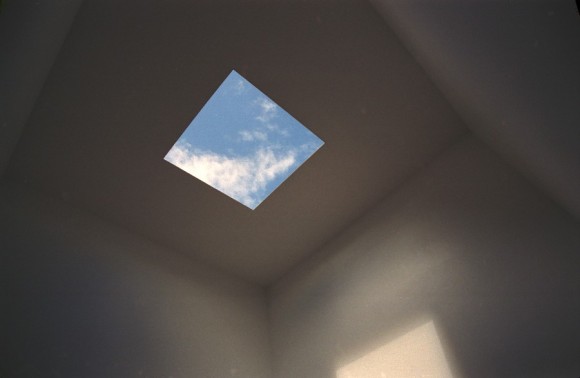Artist James Turrell has a way with light; he controls it, captures it, uses it, and exposes it. This California native has been experimenting and working with light and space for over forty years, and he has learned how to master it. From his early skyspaces to his light tunnels and projections, it is clear that Turrell is a true artist of light.
Let us examine one of his works. In the above picture, one can see the white pyramid. Yeah, cool, but it’s not that hard to build a big white pyramid. It is exceptionally hard, however, to construct such a pyramid as James Turrell has done. With some closer inspection, it becomes clear that the pyramid is actually just a set of focused light beams! The square on the floor forms the base, and the pristine, sharp, immaculate edges and point are simply light! It is astounding how Turrell can manipulate light with such precision. When one considers how easily light is flooded, diffused, or blurred, the mastery of Turrell’s work becomes apparent.
Quickly examine this work of Turrell’s as well. It may not seem so special at first– yeah cool a skylight woohoo– but thn one realizes that this is no ordinary skylight. Look at the edges of the aperture. They are immaculate. There is no depth of the roof shown. It is as if someone just pasted a picture of the sky in the middle of the roof. Turrell’s style involves sharp, uninterrupted edges associated with pristine light figures, and this is a perfect example of what sets him apart from any competition.
Once more, it appears that Turrell has simply created a luminescent mass against the corner of a room. However, upon closer inspection once again, it becomes clear that the figure is actually just manipulated light. How does Turrell do it? How does he manipulate light in such a precise way that it appears to take on a massive quality of its own? Turrell is a man who turns light into solid figures.
James Turrell’s artwork is truly moving and inspiring. It is as if he is a scientist with a doctorate in optics. Turrell is a brilliant artist, and I use his work as inspiration for my architecture. When light is done properly, it can be a truly amazing thing within a space.




This is so interesting! I actually got my first introduction to James Turrell and his work in an assigned reading from our summer studio (ARCH 2011) course – an article titled “Translations from Drawing to Building” (1997) by Robin Evans. Here’s a little passage that talks about him and his work:
“Of the works beyond the pale of architecture — earth art, performance, installations, constructions — which nevertheless deal with recognizably architectural themes, several are remarkable not just for the fact that they make little of no use of drawing, but for the impossibility of their development through this medium. The work of Los Angeles artist James Turrell may be used as an instance. The mainstay of Turrell’s work through the late 1960s and 1970s was the artificially lit room… Most architectural of these were a series of empty spaces which, if drawn up within current architectural conventions, could only construed as indicative of witless simplicity…. Evoking gushes of transcendental mystification from some critics, Turrell’s work is, all the same, quite easy to understand and appreciate since it has to do with observers not being able to believe their own eyes. You look into something which you know is another rectangular room with batteries of fluorescent tubes on the back of the partition through which you peer. You can see how it works…”